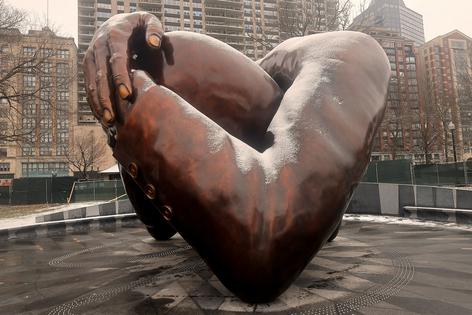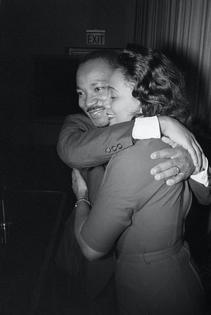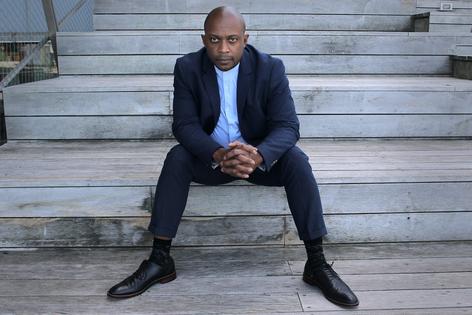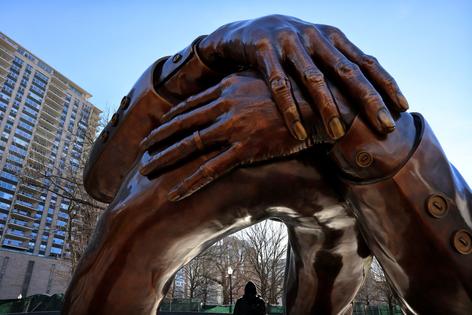Reaction to bronze sculpture of Coretta and Martin Luther King Jr. in Boston hasn't been good – and that's not bad for art that shatters conventions
Published in News & Features
As an acclaimed photographer and conceptual artist, Hank Willis Thomas has grown accustomed to criticisms of his unconventional art and concepts of identity.
But even Thomas had never experienced anything like the reaction to his latest sculpture, designed to commemorate the lives of Coretta and Martin Luther King Jr., two of the most revered civil rights leaders in modern American history.
Unveiled in January 2023, the two sets of 20-foot-tall bronze arms appear floating in air and are embracing. Those who visit the statue in Boston can also walk underneath it into the space between the Kings’ arms.
It was in Boston after all, that the two met and fell in love.
Despite the intended show of mutual affection between the Kings, many of the tweets shared on national news feeds after the unveiling were crude and misinterpreted arms for other body parts.
Tweeters decried: “Disrespectful,” “Obscene,” “Phallic,” “Gross” and “Insulting.”
In the online magazine Compact, Seneca Scott, a labor union activist and cousin of Coretta Scott King, depicted the sculpture, titled “The Embrace,” as a “masturbatory metal homage to my legendary family members” and an insult to Black people everywhere.
As a scholar of visual culture, public memorials and race, I know these reactions to a new monument are not uncommon.
In fact, outrage is the common response.
“The Embrace” is unusual and was unveiled at a time of intense national debate about the public memorials of white men and the dismal histories of representing Black people and women.
Across the U.S., Confederate monuments and statues of Christopher Columbus and Teddy Roosevelt have been passionately defended – and have come tumbling down over the past 10 years.
This sculpture is both abstract and carefully detailed – the buttons on his coat and her jewelry are clearly articulated in bronze.
Many of the critics complained that enormous floating arms of beloved civil rights leaders did a terrible disservice to the Kings.
One tweeter asked Thomas: “Why did you make it so complicated and confusing?”
Most memorials do their work with a few very familiar conventions – soldiers on horses, scantily clad buxom figures of liberty, and dignified men caught midstride, forever frozen in time.
“The Embrace” shattered those conventions – which partly explains the outrage.
In the past, the most respectful, most dignified way to represent a revered person was as fully dressed and standing tall.
“The Embrace” steps outside of memorial conventions, which is a particularly complicated thing to do when representing Black people and women.
Depicting Coretta Scott King without a whole body and without a face runs the risk of seeming to be part of a long practice of denying women the power and dignity of their male counterparts.
Most women found in public memorials are symbols of liberty, peace, justice – and at least partially naked.
They are beautiful and aspirational, and, most notably, not powerful actual people in the world.
According to Monument Lab, a public art and history nonprofit group, there are 11 times more monuments to mermaids than congresswomen in the United States.
The history of representing Black men in the United States is equally disturbing.
Figures of them are all too rare, and when they do appear, they are generic soldiers or, more often, barechested and kneeling, nameless or enslaved.
The artistic choice to depict Martin Luther King Jr. without a face, without an intact body, without the dignity of a straight back, runs the risk of robbing him of the power he risked to carve out nonviolent protests in a racially hostile country.
An artist of Thomas’ caliber and experience knows he is taking those risks, and does so intentionally.
Some of the most beloved public art has been met with calls for a wrecking ball.
Lots of folks, for example, were very upset when the Vietnam Veterans Memorial was unveiled in 1982. One critic called the monument a “black gash of shame.”
“It is an unfortunate choice of memorial,” the New Republic wrote at the time. “Memorials are built to give context and, possibly, meaning to suffering that is otherwise incomprehensible. … To treat the Vietnam dead like the victims of some monstrous traffic accident is more than a disservice to history; it is a disservice to the memory of the 57,000.”
Designed by Maya Lin, the memorial has now become one of the most cherished pieces of public art in the U.S.
Even the Eiffel Tower was considered an eyesore by high-minded Paris art critics, some of whom described it as no more than a railroad bridge turned on its side when it was finished in 1889.
Willis is no stranger to criticisms. In fact, he embraces it.
“My belief,” he told Time magazine in a January 2023 interview “is artists learn through critique. There’s things that we love that over time we get tired of, and there’s things that we’re not quite sure about at the beginning, but over time, we love.”
Such was the case in Philadelphia in 2017, when he unveiled his 8-foot-tall, 800-pound sculpture of an Afro pick topped with a clenched-fist, Black Power salute.
Officially called “All Power to All People,” the statue rests near Philadelphia City Hall on Thomas Paine Plaza and received initial rebukes but eventual praise.
But one crucial idea is missing from most of the criticisms of “The Embrace.”
In my view, memorials and monuments are not actually made to mark a shared history or to maintain the status quo, as some have argued. It’s my belief that the people who build and design them have a point they want to make in the world.
The United Daughters of the Confederacy had a vision in 1890 when it unveiled the sculpture of Confederate Gen. Robert E. Lee riding atop his horse Traveller in Richmond, Virginia.
And Thomas had his vision for “The Embrace.”
The magic of memorials and monuments is that they seem natural and eternal in our landscape but they are neither.
What Thomas does in “The Embrace” is ask us to see the Kings, simply yet powerfully, in a new light.
This article is republished from The Conversation, an independent nonprofit news site dedicated to sharing ideas from academic experts. The Conversation is trustworthy news from experts, from an independent nonprofit. Try our free newsletters.
Read more:
Friday essay: taking a wrecking ball to monuments – contemporary art can ask what really needs tearing down
Why the case for the removal of Confederate memorials isn’t so clear-cut
Kristin Ann Hass does not work for, consult, own shares in or receive funding from any company or organization that would benefit from this article, and has disclosed no relevant affiliations beyond their academic appointment.















Comments